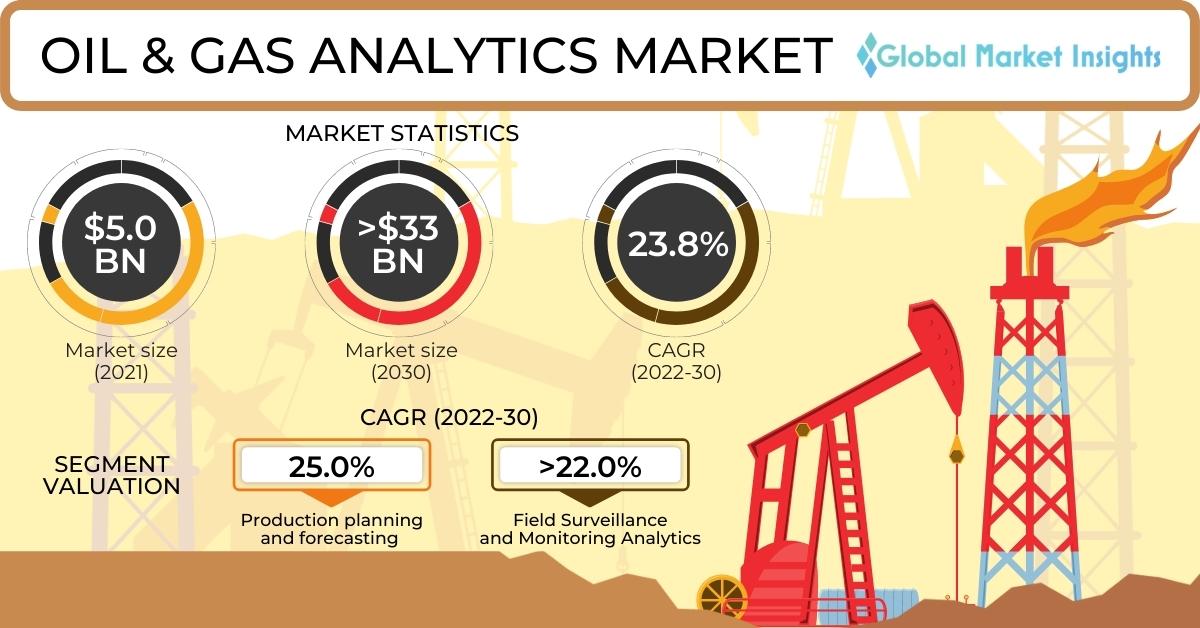Data analytics has enthralled the oil and gas (O&G) sector, whether it be for increasing ROI or improving safety measures. Using large amounts of field data and machine learning (ML) algorithms frequently, advanced analytics has enabled predictive insights that oil rig operators and managers can use to maximize yield and reduce worker risk.
For example, in offshore oil production, companies can use advanced analytics and submersible platforms to optimize production settings and increase overall output. Meanwhile, downstream and midstream organizations can use operational data analytics to optimize production and reserve recovery efforts. Importantly, O&G companies are gravitating towards big data and predictive analytics for reducing worker risk by identifying new oil and gas sources without the need to undertake potentially hazardous operations.
Certainly, there are numerous internal and external factors, right from well drilling to pipeline operations, that influence the production costs of an oil and gas organization. This information can be harnessed by big data analytics and used in various scenarios to improve production efficiency and bring down costs.
One of the key reasons oil and gas analytics tools and techniques are being adopted is to unlock the production potential of complex process facilities and enhance returns. Expansion of refineries to meet the increasing petroleum product demand is expected to boost the growth of oil and gas analytics market in the ensuing years.
Let’s have a glance at some of the ways O&G sector will benefit from analytics solutions:
Cloud technology to augment O&G analytics
Nowadays oil & gas companies are transitioning to advanced technologies like cloud computing and SaaS solutions for improving their operations. May it be upstream, midstream, and downstream, the value chain of the oil & gas industry is comprised of disconnected processes, unstructured operations, disparate eco-systems, disjointed efforts, and huge wastage of resources.
Using cloud technology and hosted solutions, engineers and analysts can access real-time data to effectively manage their asset performance. It helps oil and gas companies to reduce downtime, latency, and gain real-time access to consolidated and coherent data for analytics and draw insights for faster decision-making.
Organizations in emerging economies are also ready to adopt new technologies and spend on upgrading their infrastructure. Recently, India’s Bharat Petroleum Corporation Ltd (BPCL) joined forces with Microsoft over a strategic cloud partnership aimed at accelerating the former’s digital transformation, enhancing, and redefining customer experience, and driving innovation in the Indian oil and gas sector.
Preventive equipment maintenance to help reduce downtime
Oil and gas companies that use old machinery for their upstream, midstream, and downstream operations are required to undertake periodic inspection and maintenance to keep them running. However, despite this, there is no absolute guarantee that such reactive maintenance can avert unplanned downtime.
A report by General Electric (GE) claims that offshore O&G companies experience financial impacts of around $49 million annually due to unplanned downtime, which could exceed further in worst-case scenario. Operators using a predictive, data-based approach can experience 36% less unplanned downtime which could result in, on average, $17 million dropping to the bottom line annually.
Currently, only 24% of operators are said to be using a predictive maintenance approach that is based on data and analytics. Using predictive maintenance and analytics, these companies can identify equipment performance by comparing its historical and real-time operating data.
They can also leverage IIoT-enabled technology, such as remote sensor data, to predict maintenance requirements, thereby cutting maintenance costs, reducing unplanned equipment failures, and improving asset management. By aggregating vast amounts of real-time operational data from sensors regarding equipment lubrication, thermography, circuitry, and more, companies can spot patterns needed to optimize field operations.
The advent of technologies like machine learning algorithms is expected to further help O&G firms to better track the wear and tear of equipment. The firms can predict possible failures and initiate precise maintenance tasks to fix anomalies, increase production, and prevent pricy breakdowns.
Rise in exploration and drilling activities
The oil and gas industry has become a massive data-intensive industry with the use of data recording sensors in exploration, drilling, and production operations. By leveraging data analytics solutions, energy providers are reducing drilling time and increasing drilling safety. They can also achieve improvement in reservoir characterization and simulation, optimize the performance of production pumps, refine petrochemical assets as well as enhance shipping and transportation.
Despite current crude oil prices, most O&G companies are looking to invest in digital technologies like cloud and analytics solutions. According to a survey conducted by Microsoft and Accenture a few years ago, approximately 80% of the oil and gas sector was likely to invest 18% to 44% in digitalization over coming years.
Based on numerous advantages and benefits of analytics solutions stated above, the global oil and gas analytics market is expected to attract extensive proceeds over the next few years. The technology will benefit organizations with regard to improved field asset monitoring and surveillance, production planning and labor management. Significant investments in the U.S. and Middle East to expand existing O&G fields will highlight the need for relevant analytics solutions.
